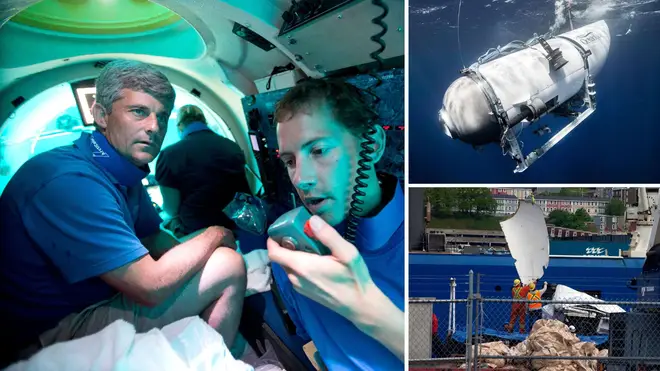
Nick Abbot 10pm - 1am
5 July 2023, 12:22 | Updated: 11 July 2023, 19:30

Concerns about the Titan sub thought to have suffered a catastrophic implosion, killing all five aboard, were raised in the years prior to the doomed mission to the Titanic.
Multiple reports of experts questioning the safety of the submarine have emerged since the vessel vanished in June - with its debris later found on the sea bed.
Canadian authorities are investigating what happened and have pulled some of the wreckage ashore, which showed how severely the Titan had shattered.
Read More: OceanGate CEO Stockton Rush compared glue holding Titan sub together to peanut butter
The tragedy killed Stockton Rush, the CEO of OceanGate, which owned the vessel, as well as British billionaire Hamish Harding, French explorer Paul Henry Nargeolet, businessman Shahzada Dawood and his son, Suleman.
These are the alleged issues that emerged before the journey.

Arnie Weissmann, editor-in-chief of Travel Weekly, said he spoke to Mr Rush about the carbon fibre used in the Titan's hull, which has been questioned.
He said Rush told him he bought carbon fibre for the sub "at a big discount" because "it was past its shelf life use in airplanes".
Speaking to the Washington Post, Mr Weissmann recalled: "I responded right away, saying, 'Don’t you have any concerns about that?’
"He was very dismissive and said: 'No, it's perfectly fine. Having all these certifications for airplanes is one thing, but the carbon fibre was perfectly sound.'"
Some experts have argued carbon fibre should not have been used, and suggested water could have seeped into space between the carbon fibre and titanium.
But this will not be known until the official investigation is concluded.

The Titan was damaged after a lightning strike in the Bahamas, Rush revealed in 2020.
He said the sub was hit during a test dive in 2018 in an episode that has again raised questions about the carbon fibre hull.
Rush admitted if the lightning had hit it directly it could have could have had deadly consequences.
"Fortunately, it was not a direct strike," he told Matt Burdyny, the vice president of Teledyne Marine.
"A direct strike to the carbon fibre probably would have taken us totally out."

One of the starkest images from OceanGate's material released before the disaster were photos of crew members using a games controller to operate the sub.
OceanGate said it was using the controller as one of several off-the-shelf parts to construct the sub.
Mr Rush was filmed by CBS in 2022, telling a correspondent: "We run the whole thing with this game controller."
It is unknown if it had any customisation beyond being hooked up to the sub.
Read more: Who was Stockton Rush? The OceanGate CEO and explorer killed in Titanic sub 'catastrophic implosion'

Concerns by a former OceanGate employee have emerged since the disaster.
David Lochridge was raising the alarm about a raft of issues onboard when he carried out a check on the Titan.
According to the New Yorker, he found an iridium satellite beacon had been secured with zip ties, the floor was highly flammable and thruster cables represented "snagging hazards".
Lochridge, who worked as director of marine operations, was sacked after voicing his worries.
He ultimately warned Rush risked killing "himself and others in the quest to boost his ego" and branded the Titan "an accident waiting to happen".
Footage shows how Rush spoke about a crew member reporting a loud bang on the sub when it was on the surface.
But he dismissed it in a clip from The Travel Show on the BBC, saying all subs make some kind of noise.
Separately, a sub expert told him he heard a "flaw" that sounded like part of the craft was being crushed or damaged.
Karl Stanley was invited by Stockton Rush to try the vessel in the Bahamas in April 2019.
Rush took the controls and told Stanley that the noise he heard was just creaking.
But Stanley, who runs a tourist submersible firm in Honduras, said it dawned on him after that the noise probably indicated a danger.
He sent an email to Rush, setting out his belief that it "sounded like a flaw/defect in one area being acted on by the tremendous pressures and being crushed/damaged".
Emails obtained by the New York Times show he worried part of the hull "is breaking down" and he said Rush should go slower with making the sub. He said he got no reply.
Jay Bloom and his son Sean, 20, spoke to CNN to share their “red flags” that stopped them from boarding the craft.
Sean said: “Before the news initially broke and we were thinking about going on the submarine ourselves, one of the safety concerns I had before getting on was literally about the structural integrity of the submarine.
“ Before we got on I saw a video of Stockton [Rush] explaining how the submarine worked with the [video game] remote and everything and I saw a lot of red flags with it and it was only meant for five people.
“I just didn’t think it could survive going that low in the ocean so ultimately I ended up warning my dad about it and he ended up agreeing with me.”
Jay added: “I think his [Stockton’s] heart was in the right place and he was passionate about his project and believed everything he was saying. But one of the things that concerned me was he told me he was flying in to see me and said he was flying in at North Las Vegas Airport, which is an odd selection.
“I asked him why and he said he was a two-seater experimental plane that he built.”
He said he thought it meant Rush had a “different risk appetite than I do.”